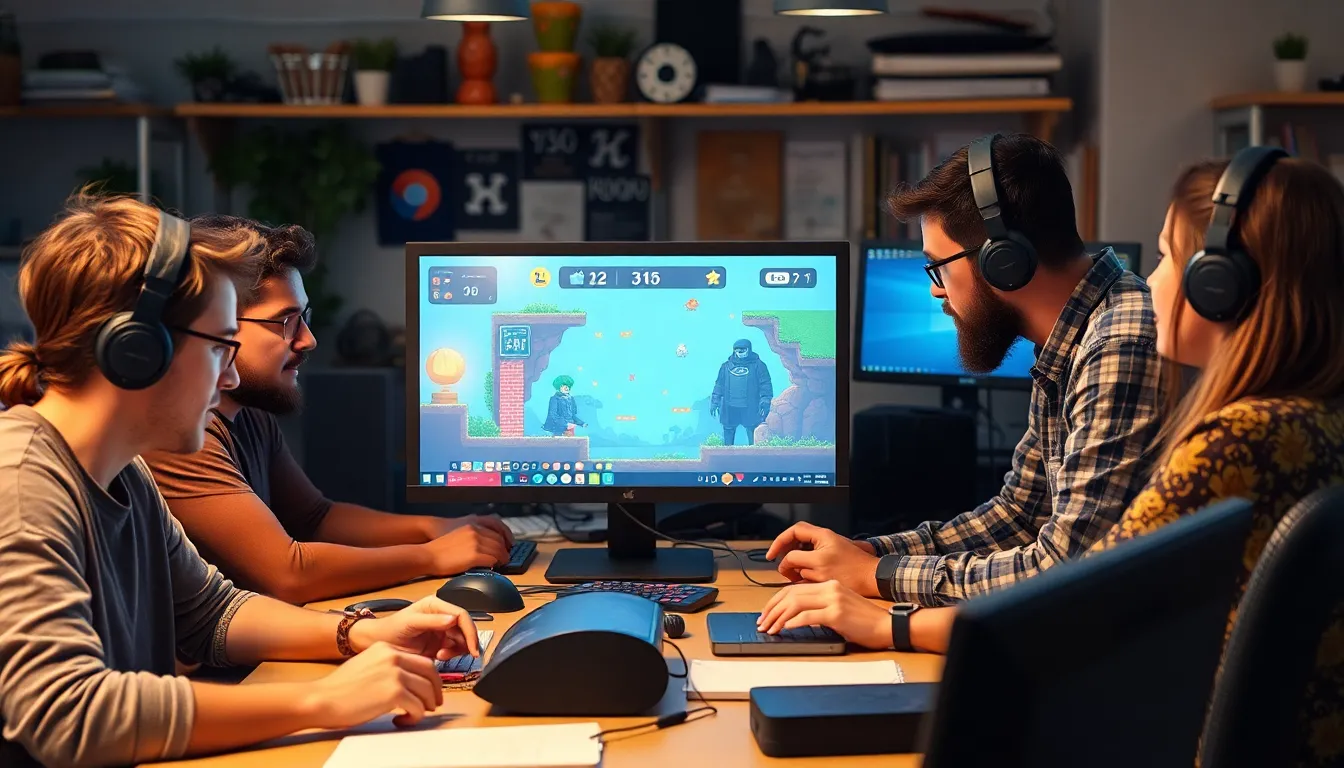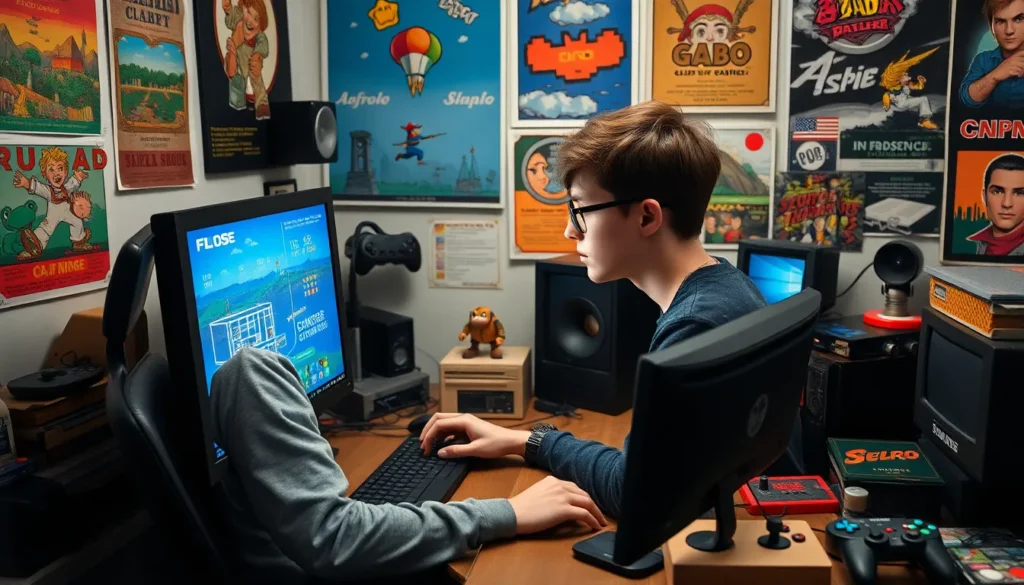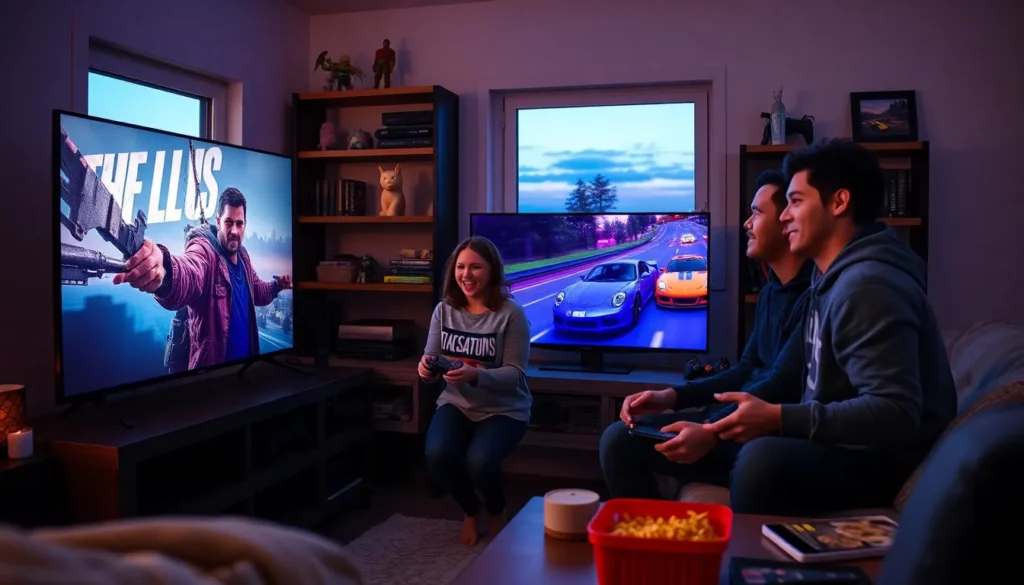Table of Contents
ToggleIn a world where graphics keep getting sleeker and more complex, there’s something undeniably charming about the pixelated nostalgia of 8-bit games. These retro gems may seem simple, but they pack a punch in creativity and fun. Whether it’s the triumphant music that plays when you level up or the thrill of dodging a pixelated enemy, 8-bit games have a special place in the hearts of gamers everywhere.
Diving into 8-bit game development isn’t just for the tech-savvy; it’s an adventure waiting to unfold. With a bit of coding magic and a sprinkle of imagination, anyone can create their own pixelated masterpiece. So grab your virtual paintbrush and get ready to embark on a journey through the whimsical world of 8-bit gaming, where every pixel tells a story and every game is a chance to relive the glory days of gaming.
Overview of 8-Bit Game Development
8-bit game development thrives on simplicity and creativity. Developers create engaging experiences using minimal resources and nostalgic designs.
The History of 8-Bit Gaming
8-bit gaming emerged in the late 1970s with the introduction of home consoles like the Atari 2600. Nintendo’s NES popularized 8-bit graphics in the mid-1980s, capturing gamers’ hearts with titles like Super Mario Bros and The Legend of Zelda. This era fostered a rich ecosystem where developers experimented with storytelling and gameplay mechanics, laying the groundwork for future innovations. The charm of 8-bit games continues to influence modern developers through retro-inspired titles, showcasing the lasting impact of this gaming revolution.
Key Features of 8-Bit Graphics
8-bit graphics showcase a distinct pixelated aesthetic, defined by limited color palettes and resolutions. Developers emphasize character sprites and tile-based environments, creating visually appealing worlds with simple shapes. Each pixel holds significance, contributing to the game’s overall feel and nostalgia. Retro sound effects and chiptune music complement the visuals, enhancing immersion. Despite technical limitations, creativity flourishes as developers find innovative ways to convey complex ideas through minimalistic design. This unique style resonates with players, often evoking fond memories of early gaming experiences.
Tools and Technologies

8-bit game development relies on various tools and technologies to bring creative visions to life. Understanding these resources enhances the development journey.
Popular Game Engines for 8-Bit Development
Construct 2, GameMaker Studio, and Unity are popular choices among developers. Construct 2 simplifies the development process with its drag-and-drop interface, while GameMaker Studio offers robust features for 2D game creation. Unity, known for its versatility, accommodates 8-bit aesthetics through custom pixel shaders. Each engine includes supportive communities, providing resources for troubleshooting and inspiration. These tools enable creators to focus on gameplay and storytelling, enhancing the overall gaming experience.
Programming Languages Used
C, C++, and JavaScript frequently appear in 8-bit game development. C and C++ supply the performance necessary for low-level graphics manipulation, making them ideal for retro-style games. JavaScript, often used with HTML5, facilitates web-based 8-bit games, enhancing accessibility. Developers may also explore specific programming libraries like p5.js, which streamline the coding process for visual projects. Combining these languages equips developers with the flexibility to innovate within the constraints of 8-bit technology.
Game Design Principles
Game design principles form the backbone of engaging 8-bit experiences. Understanding these principles enhances creativity and helps developers craft memorable gameplay.
Mechanics and Gameplay
Gameplay mechanics shape how players interact with a game. Simple controls, clear objectives, and rewarding feedback encourage engagement. Developing intuitive mechanics, such as platforming or puzzle-solving, fosters enjoyment. Crafting challenges that gradually increase in difficulty keeps players invested. Incorporating power-ups or collectibles adds excitement and provides motivation to explore. Balance between challenge and accessibility ensures players remain engaged without frustration.
Art and Sound Design
Art and sound design significantly influence the atmosphere of 8-bit games. Pixel art creates a nostalgic aesthetic, often limited to a specific color palette that emphasizes creativity. Characters, backgrounds, and animations reflect the game’s theme and enhance immersion. Sound effects and chiptune music contribute to the emotional resonance, evoking nostalgia and excitement. Together, art and sound shape the player’s experience, making each moment memorable. Prioritizing coherence between visuals and audio enhances overall gameplay satisfaction.
Challenges in 8-Bit Game Development
Developing 8-bit games presents unique challenges despite the charm and creativity involved. Understanding these obstacles can enhance the development experience.
Technical Limitations
Technical constraints play a significant role in 8-bit game development. Limited processing power restricts graphics and sound quality. Developers face challenges in optimizing code to achieve smoother gameplay. Memory limitations force developers to use simplistic graphics, urging them to be resourceful with designs. Tile-based environments demand careful planning to create cohesive levels. Each pixel must serve a purpose within the constrained space, emphasizing efficiency in design. Overall, tackling these limitations requires creativity and innovation.
Balancing Nostalgia and Modern Expectations
Developers struggle to balance nostalgia while meeting modern player expectations. Modern gamers often expect superior graphics and complex mechanics. Heeding this demand can challenge 8-bit developers who strive to retain a retro feel. Implementing nostalgia-triggering elements, such as pixel art and chiptune music, enhances immersion. Yet, developers must innovate gameplay to keep players engaged. Striking this balance ensures that games resonate with both nostalgic and new audiences. Ultimately, developers aim to create experiences that satisfy diverse player preferences.
Success Stories in 8-Bit Gaming
8-bit gaming has produced iconic titles that continue to influence developers. Numerous success stories reflect the creativity and innovation inherent in this genre.
Influential 8-Bit Games
Games like Super Mario Bros., The Legend of Zelda, and Tetris stand out as monumental achievements in 8-bit gaming. Each title introduced unique gameplay mechanics, redefining player experiences at their time of release. Super Mario Bros. established platforming as a genre, while The Legend of Zelda combined exploration with puzzle-solving. Tetris revolutionized puzzle games with its simple yet addictive gameplay. Such groundbreaking titles set the standard for future generations of games, highlighting the lasting appeal of 8-bit design.
Case Studies of Successful Developers
Developers like Derek Yu, creator of Spelunky, demonstrate how 8-bit aesthetics can transcend nostalgia. Drawing inspiration from classic games, he crafted experiences that appeal to modern audiences. Another noteworthy example is Thomas Happ, responsible for Axiom Verge, which showcases how 8-bit graphics can blend with intricate storytelling. These developers illustrate that even with technical limitations, creativity and innovation yield success in the gaming industry. Each case reflects the potential of combining retro styles with contemporary design philosophies.
The world of 8-bit game development remains a vibrant playground for creativity and innovation. With its unique blend of nostalgia and simplicity, it invites both seasoned developers and newcomers to explore their artistic visions. By leveraging accessible tools and embracing the charm of pixelated graphics, anyone can embark on a journey to create engaging experiences that resonate with players.
As the gaming landscape continues to evolve, 8-bit games remind everyone of the joy found in simplicity and imaginative storytelling. Whether it’s the challenge of optimizing gameplay or crafting memorable soundscapes, the spirit of 8-bit gaming encourages exploration and experimentation. This enduring genre not only honors the past but also inspires future generations of developers to push the boundaries of what’s possible within its pixelated confines.







